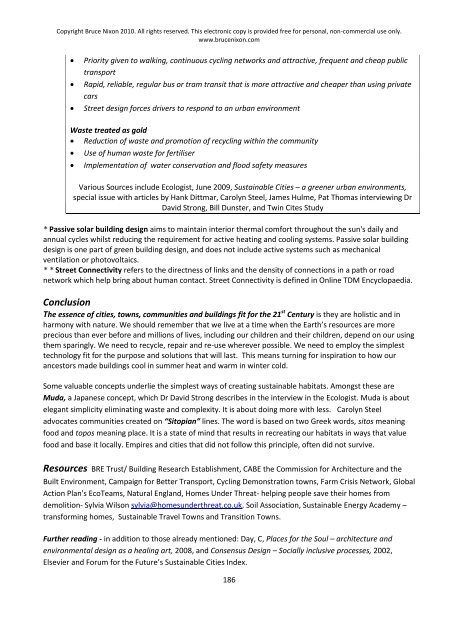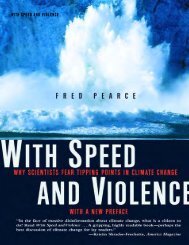A better world is possible - Global Commons Institute
A better world is possible - Global Commons Institute
A better world is possible - Global Commons Institute
You also want an ePaper? Increase the reach of your titles
YUMPU automatically turns print PDFs into web optimized ePapers that Google loves.
Copyright Bruce Nixon 2010. All rights reserved. Th<strong>is</strong> electronic copy <strong>is</strong> provided free for personal, non-commercial use only.<br />
www.brucenixon.com<br />
<br />
<br />
<br />
Priority given to walking, continuous cycling networks and attractive, frequent and cheap public<br />
transport<br />
Rapid, reliable, regular bus or tram transit that <strong>is</strong> more attractive and cheaper than using private<br />
cars<br />
Street design forces drivers to respond to an urban environment<br />
Waste treated as gold<br />
Reduction of waste and promotion of recycling within the community<br />
<br />
<br />
Use of human waste for fertil<strong>is</strong>er<br />
Implementation of water conservation and flood safety measures<br />
Various Sources include Ecolog<strong>is</strong>t, June 2009, Sustainable Cities – a greener urban environments,<br />
special <strong>is</strong>sue with articles by Hank Dittmar, Carolyn Steel, James Hulme, Pat Thomas interviewing Dr<br />
David Strong, Bill Dunster, and Twin Cites Study<br />
* Passive solar building design aims to maintain interior thermal comfort throughout the sun's daily and<br />
annual cycles whilst reducing the requirement for active heating and cooling systems. Passive solar building<br />
design <strong>is</strong> one part of green building design, and does not include active systems such as mechanical<br />
ventilation or photovoltaics.<br />
* * Street Connectivity refers to the directness of links and the density of connections in a path or road<br />
network which help bring about human contact. Street Connectivity <strong>is</strong> defined in Online TDM Encyclopaedia.<br />
Conclusion<br />
The essence of cities, towns, communities and buildings fit for the 21 st Century <strong>is</strong> they are hol<strong>is</strong>tic and in<br />
harmony with nature. We should remember that we live at a time when the Earth’s resources are more<br />
precious than ever before and millions of lives, including our children and their children, depend on our using<br />
them sparingly. We need to recycle, repair and re-use wherever <strong>possible</strong>. We need to employ the simplest<br />
technology fit for the purpose and solutions that will last. Th<strong>is</strong> means turning for inspiration to how our<br />
ancestors made buildings cool in summer heat and warm in winter cold.<br />
Some valuable concepts underlie the simplest ways of creating sustainable habitats. Amongst these are<br />
Muda, a Japanese concept, which Dr David Strong describes in the interview in the Ecolog<strong>is</strong>t. Muda <strong>is</strong> about<br />
elegant simplicity eliminating waste and complexity. It <strong>is</strong> about doing more with less. Carolyn Steel<br />
advocates communities created on “Sitopian” lines. The word <strong>is</strong> based on two Greek words, sitos meaning<br />
food and topos meaning place. It <strong>is</strong> a state of mind that results in recreating our habitats in ways that value<br />
food and base it locally. Empires and cities that did not follow th<strong>is</strong> principle, often did not survive.<br />
Resources BRE Trust/ Building Research Establ<strong>is</strong>hment, CABE the Comm<strong>is</strong>sion for Architecture and the<br />
Built Environment, Campaign for Better Transport, Cycling Demonstration towns, Farm Cr<strong>is</strong><strong>is</strong> Network, <strong>Global</strong><br />
Action Plan's EcoTeams, Natural England, Homes Under Threat- helping people save their homes from<br />
demolition- Sylvia Wilson sylvia@homesunderthreat.co.uk, Soil Association, Sustainable Energy Academy –<br />
transforming homes, Sustainable Travel Towns and Transition Towns.<br />
Further reading - in addition to those already mentioned: Day, C, Places for the Soul – architecture and<br />
environmental design as a healing art, 2008, and Consensus Design – Socially inclusive processes, 2002,<br />
Elsevier and Forum for the Future’s Sustainable Cities Index.<br />
186
















